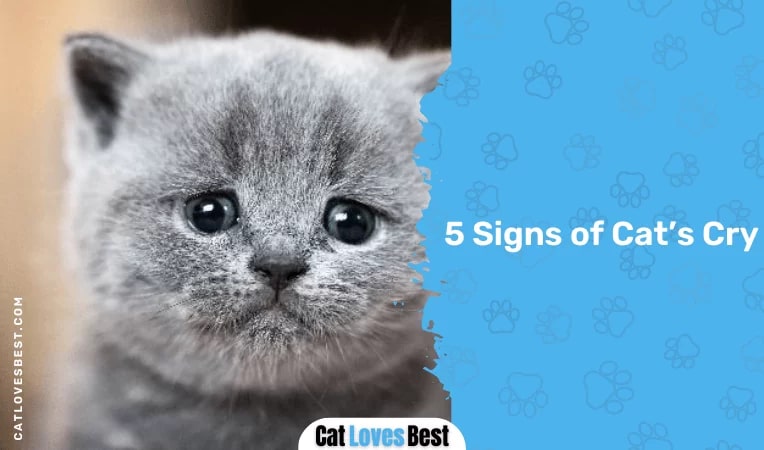Cats are the most skittish animal on the earth! They can be dramatic too! But do cats cry? The short answer is no! Cats do not cry you won’t find her weeping or sobbing, like a movie character, when their loved ones die.

If you witness tears in your cat’s eye after you come home from a long day, and you be like, oh my goodness! My cat loves me so much! Take a pause, your heart is going to break.
The only possible reason for your feline buddy having tears in her eyes is due to medical conditions, they don’t represent their sadness through tears.
Can Cats Cry Tears?
The short answer is no, cats can’t cry tears. In fact, cats crying tears can be a sign of debris, a scratch on your cat’s eye, or other medical problems. But when they get upset or unhappy they can do a vocalization, and they can scream out in pain, but not cry.

In the cat’s world, they don’t express their sadness by rolling down tears from their eyes, instead, they would use body language to indicate their sadness. For example, if your cat is sad, upset, or scared she will engage in excessive meowing, (vocalization), ears held back, and a tucked tail.
So, we know now how our kitties indicate sadness!
But what to assume when you see tears in your cat’s eyes?
Most likely, there is a number of reasons which give your cat watery eyes, it indicates health issues. Cognitive, infections, and food allergies. Three prominent root causes.
5 Signs of Cat’s Cry

After our cats have rejected to cry dramatically in the Hollywood style! We need to find another alternative to detect their cry.
We have mentioned the five signs of cats cry for you to discover the seriousness of their condition.
1. Defecating inside the House
After the training period, your cats tend to follow the litter habits without fail. But if you notice them doing the exact opposite of that, then it is a red indication for you.
- Cats when feel stressed, they often defeat everywhere but the litter box.
- Worms, gastric issue or stomach bug unquestionably disturbs your cat’s pooping habit.
- Older cats develop osteoarthritis, which triggers going outside the litter tray very common.
So, if this continues, we would suggest you take your buddy to the vet.
2. Hiding
This point might surprise you, as we all know how expert cats are in ghosting us for hours and then coming back like they never left. Somewhat of the spooky nature is permitted, but too much of it? No! It definitely exhibits something else.
When you try to pet her after she comes back from her long ghosting sessions, she jumps, runs away from you. Which indicates the pain she’s having, and it would get triggered by your touch. you need to observe her more before jumping to a conclusion.
Like, look for if she’s having any difficulty in climbing the stairs or hopping on the bed, once you detect them you are free to decide whether she needs some time off or requires to be taken to the vet.
3. Hiss and Bite
Every cat owner has been through the phase where his/her cat would scrap off the skin through her nails. Now that’s a form of love! And you relish it even after being in pain.

What’s not normal is frequent hissing and biting!
Cats show this aggressive behavior when they are touched at particular spots, which symbolizes pain. So if your cat is being extra aggressive with you, it’s time to take proper care of it. So teary eyes or tears when they’re sad has nothing to do with emotions with a cat.
Cats, with osteoarthritis, often show these characteristics.
4. Walking Unsteady
If you have a cat who suddenly started walking like she just had 5 shots of tequila, then instead of making a funny video of her for your Instagram, pause and pay attention.
Your feline might be aching from wobbly kitty syndrome! Sound scary right? let’s dig deeper and determine how much care you need to take of her!
Wobbly kitty syndrome in felines is a disorder related to neurology that leads to loss of balance, uncoordinated motion, as well as sudden jerky movements.
Usually, a good part is this syndrome doesn’t grow in your cat, so eventually, it won’t be any worse than it is right now! The bad part is that your cat has to cope up with it for the rest of her life.
5. Anorexia
Anorexia in cats is particularly triggered by three things:
- Cats are picky eaters and would prefer starving than eating their undesirable food, item! Yes, cats do act sometimes as brats.
- Cats when suffering from medical issues such as cat flu, diabetes, viral diseases, hyperthyroidism, pancreatitis, dental problems, pain, clogged tear ducts and internal obstructions stop eating.
- You should make sure that they don’t go without eating for more than 24 hours!
Conclusion
Do cats cry? So the bottom line is that the only time you will witness tears in your cat’s eyes is because she is facing medical issues and not an emotional trauma! But does that mean, they’re feeling-less, or they won’t get sad? Well no! Cats do have feelings and they can get sad.
Just their way is different from ours. So from the next time when you see them crying tears, check for the possible physical reasons behind it.
References
- Cri-Du-Chat (Cat’s Cry) Syndrome – Healthline
- Why is my cat crying? – MSPCA Angell
- How do cats communicate with each other? – Library of Congress

